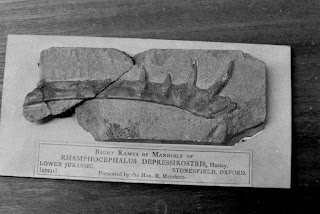A couple of days ago I received an enquiry about photographs of some of the obscure type specimens - the sort of fossils that are outside of the main stream of research because they are generally fragmentary remains. To see if I could provide such photographs I searched my collection of images. Very little joy in that search as I could only find two of the images, and they were of poor quality. This inspired me to do a bit more with my negatives.
I do have some old photographs which go back to 1975 and they are mostly kept as negatives or 35mm slides. This mandible of Rhamphocephalus was taken at the Natural History Museum, London, in 1976; then the British Museum of Natural History. It is digitised from a black and white negative using a film copier and it has remained good after 36 years in storage.
This image is of the upper and lower mandible of Istiodactylus in the University Museum of Zoology, Cambridge, taken in 1986. The picture was taken using a cheap colour positive film and the chemistry of the slide has changed, degrading the image significantly.
Time is important in protecting old images. The digital versions may often be less pixilated than good quality film images, but they do not degenerate in the same way. I now keep all of my digital images on a separate hard drive in two files, my copyright and other peoples copyright. This drive is backed up an a secure separate hard drive on a monthly basis and most of the images are also stored on a DVD disc. This ensures that in the event of a crisis, some images will be preserved.
In my office are two boxes of slides and negatives which still need to be digitised. Some have degraded considerably and may well never be recovered.
I am now looking for photographic images of the following specimens;
Natural History Museum, London
R176 Istiodactylus latidens
37002 Rhamphorhynchus longipes
42735 (Pterodactylus
pulchellus) Pterodactylus micronyx
37990 (Pterodactylus
longicollum) Diopocephalus longicollum
1640 (Cimoliornis diomedeus) Ornithocheirus diomedius
Sedgwick Museum, Cambridge
B54.443 (Ornithocheirus brachyrhinus)
B54.437 or
B54.438 (Ornithocheirus carteri)
B54.499
(Ornithocheirus crassidens) Amblydectes crassidens
B54.544 (Ornithocheirus dentatus)
B54.444
(Ornithocheirus enchorhynchus)
B54.644 (Ornithocheirus
eurygnathus) Amblydectes eurygnathus
87822
(Ornithocheirus huxleyi) Lonchodectes oweni
B54.835
(Ornithocheirus platystomus) Amblydectes platystomus
B54.440 (Ornithocheirus polyodon) Seeley 1870
B54.441 (Ornithocheirus scaphorhynchus) Lonchodectes scaphorhynchus
If you have such images that you are willing to share, please send them to
pterosaur@ntlworld.com




